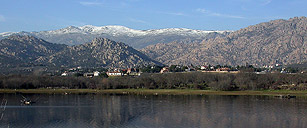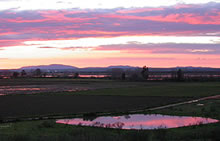 |
Spain: birds and birdwatching - part 1
by John Muddeman
Spain - geography and climate
The birds in Spain are diverse and still relatively abundant. This is due to a
combination of factors outlined below, including Spain's geographical location, great
variation in the local geography and topography of the Iberian Peninsula, including
over short distances, and the correspondingly wide range of microclimates present.
Mainland Spain, with its mainly warm and dry southern Mediterranean coasts, cooler, wetter
and wilder northern Atlantic coasts, lower southern and higher northern inland plains and a
 Mediterranean habitats in Extremadura
© John Muddeman
series of high mountain ranges including the Pyrenees, Cantabrican range, Sistema Central and
Sierra Nevada amongst others, supports a massive diversity of habitats, and consequently,
birds.
Mediterranean habitats in Extremadura
© John Muddeman
series of high mountain ranges including the Pyrenees, Cantabrican range, Sistema Central and
Sierra Nevada amongst others, supports a massive diversity of habitats, and consequently,
birds.
This variety is perhaps best encapsulated in SW Spain, in the region of Andalucía. True
semi-desert exists in the Cabo de Gata area in Almería, yet one of the areas of highest
rainfall in the peninsula lies not too far way to the west, in the province of Cádiz. Here,
weather fronts charged with moisture move in from the Atlantic and drop this load as rain on
the first mountains they hit, the Sierra de Grazalema, rich in limestone and botanical
delights as a result, and even, overlooking the Strait of Gibraltar, harbouring a few relicts
from the sub-tropical flora of earlier eras. Add to this the highest mountain in mainland
Spain, Pico Mulhacén in Sierra Nevada, where true alpines cling on, many of them unique
endemics or more closely related to N African than European species, and one begins to see
that Spain is a land of enormous contrasts and variety.
 Manzanares el Real, Sistema Central
© John Muddeman
Manzanares el Real, Sistema Central
© John Muddeman
It is also one of the sunniest and hottest countries in Europe, but inland and in the
mountains, with numerous peaks and ridges over 2000m in height, it can also be cold at times.
Given the enormous extension of the country, a typically continental climate is seen in many
areas, with summer to winter max. / min. contrasts of up to 50°C. The majority of the
country is considered to be under the influence of a Mediterranean climate, characterised
by long, usually hot and dry summers and the main rainy periods in spring and autumn,
though these are notably erratic in character. The Cantabrican mountains (especially the
N slopes) and Pyrenees are also in line with many weather systems which roll in off the
Atlantic and seem to follow their line (even to Catalonia in the far NE) and receive more
regular rain than anywhere else, especially in Galicia (the far NW), with its intricate
 Sunset over ricefields, Extremadura
© John Muddeman
coastline jutting out between the Bay of Biscay and the 'true' Atlantic.
Sunset over ricefields, Extremadura
© John Muddeman
coastline jutting out between the Bay of Biscay and the 'true' Atlantic.
The climate, combined with relatively low human population (approx. 52 million) and only
relatively recent modernisation have left the country with a legacy of currently relatively
intact habitats. This includes some of the best agricultural habitats for wildlife in Europe
and huge areas of man-modified landscape of numerous types still attractive to a wide range
of species. The pressures on these are now intense however, with ever more habitats and sites
disappearing or being damaged under the euphemism of 'progress', especially under modern
agricultural and building policies.
Despite the popular image of Spain as bull fighting, flamenco dancing and mass tourism on
the beaches of Alicante, Málaga, the Balearic Islands (especially Mallorca and Ibiza) or the
Canary Islands (e.g. Lanzarote, Fuerteventura, Gran Canaria and Tenerife), just a few
kilometres away from many of these sites, wildlife often still abounds for those willing to
take a look.
|